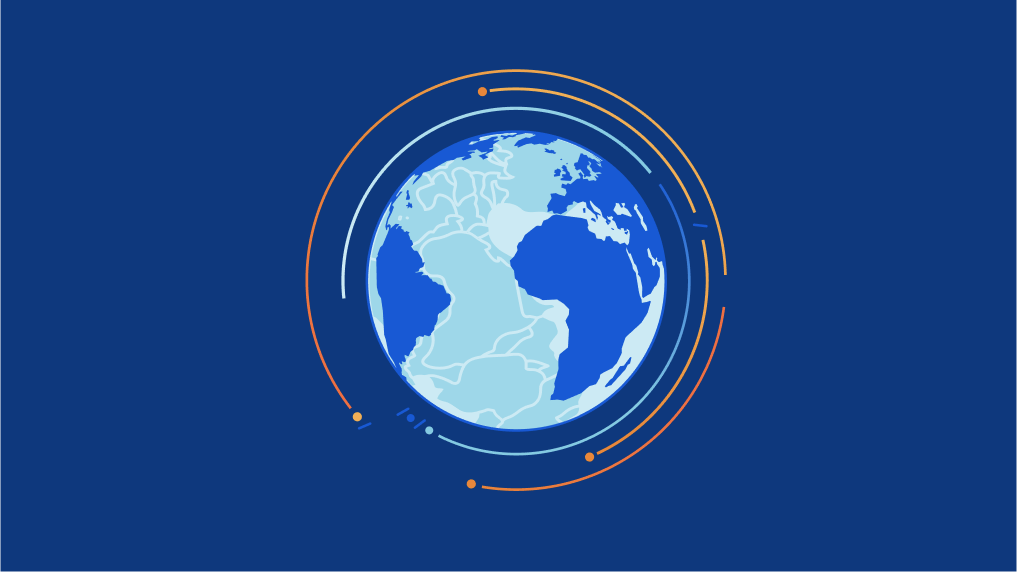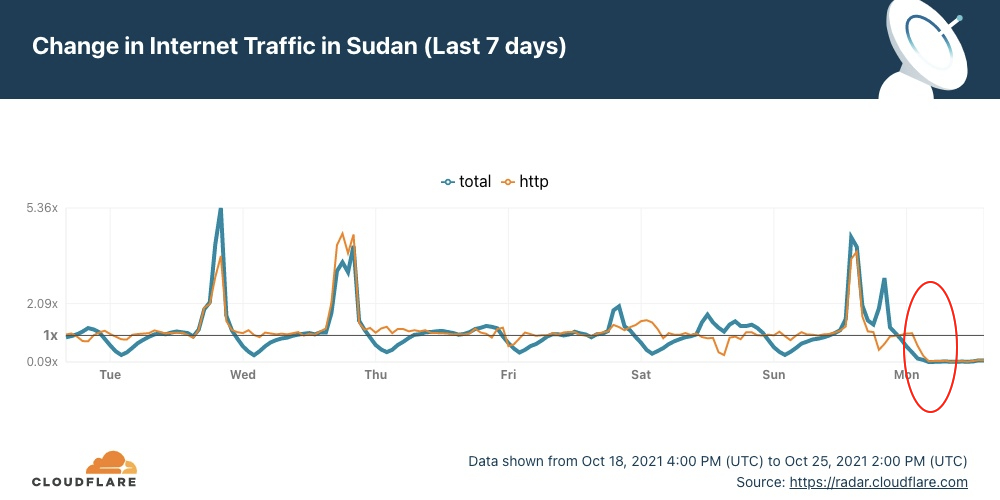The Three Key Factors For a Successful SD-WAN Project
Aruba Networks has collected customer best practices and guidance on what it takes for a successful SD-WAN implementation. Those stories and best practices have been captured in a new eBook from Aruba, available now.
The post The Three Key Factors For a Successful SD-WAN Project appeared first on Packet Pushers.
Sudan woke up without Internet


Today, October 25, following political turmoil, Sudan woke up without Internet access.
In our June blog, we talked about Sudan when the country decided to shut down the Internet to prevent cheating in exams.
Now, the disruption seems to be for other reasons. AP is reporting that "military forces ... detained at least five senior Sudanese government figures.". This afternoon (UTC) several media outlets confirmed that Sudan's military dissolved the transitional government in a coup that shut down mobile phone networks and Internet access.
Cloudflare Radar allows anyone to track Internet traffic patterns around the world. The dedicated page for Sudan clearly shows that this Monday, when the country was waking up, the Internet traffic went down and continued that trend through the afternoon (16:00 local time, 14:00 UTC).

We dug in a little more on the HTTP traffic data. It usually starts increasing after 06:00 local time (04:00 UTC). But this Monday morning, traffic was flat, and the trend continued in the afternoon (there were no signs of the Internet coming back at 18:00 local time).

When comparing today with the last seven days' pattern, we see that today's drop is abrupt and unusual.

We can see Continue reading
Tech Bytes: Cloud Agility, On-Prem Performance With Pluribus And ITRenew (Sponsored)
Today on the Tech Bytes podcast we’re talking about how to get cloud agility on premises. Our sponsor is Pluribus Networks, which makes data center SDN software. They’ve brought along partner ITRenew, which specializes in providing high-performance rack-level infrastructure. We talk about how Pluribus and ITRenew come together to deliver a private cloud.
The post Tech Bytes: Cloud Agility, On-Prem Performance With Pluribus And ITRenew (Sponsored) appeared first on Packet Pushers.
Tech Bytes: Cloud Agility, On-Prem Performance With Pluribus And ITRenew (Sponsored)
Today on the Tech Bytes podcast we’re talking about how to get cloud agility on premises. Our sponsor is Pluribus Networks, which makes data center SDN software. They’ve brought along partner ITRenew, which specializes in providing high-performance rack-level infrastructure. We talk about how Pluribus and ITRenew come together to deliver a private cloud.Network Break 356: Aruba Beefs Up ToR Switch With DPUs; VMware Stands Free
This week on the Network Break podcast we discuss a new ToR switch from Aruba that includes built-in silicon to offload security and network services. Dell Technologies says the VMware spin-off will be complete by November 1st, and SASE startup Cato Networks raises $250 in an F round of funding.
The post Network Break 356: Aruba Beefs Up ToR Switch With DPUs; VMware Stands Free appeared first on Packet Pushers.
Network Break 356: Aruba Beefs Up ToR Switch With DPUs; VMware Stands Free
This week on the Network Break podcast we discuss a new ToR switch from Aruba that includes built-in silicon to offload security and network services. Dell Technologies says the VMware spin-off will be complete by November 1st, and SASE startup Cato Networks raises $250 in an F round of funding.Cloudflare Tunnel for Content Teams


A big part of the job of a technical writer is getting feedback on the content you produce. Writing and maintaining product documentation is a deeply collaborative and cyclical effort — through constant conversation with product managers and engineers, technical writers ensure the content is clear and serves the user in the most effective way. Collaboration with other technical writers is also important to keep the documentation consistent with Cloudflare’s content strategy.
So whether we’re documenting a new feature or overhauling a big portion of existing documentation, sharing our writing with stakeholders before it’s published is quite literally half the work.
In my experience as a technical writer, the feedback I’ve received has been exponentially more impactful when stakeholders could see my changes in context. This is especially true for bigger and more strategic changes. Imagine I’m changing the structure of an entire section of a product’s documentation, or shuffling the order of pages in the navigation bar. It’s hard to guess the impact of those changes just by looking at the markdown files.
We writers check those changes in context by building a development server on our local machines. But sharing what we see locally with our stakeholders has Continue reading
Feedback: How Networks Really Work
A few weeks ago I asked my subscribers which webinar they’d like to see in November (thanks a million to everyone who replied!). Not surprisingly, network automation got the top spot, but I was a bit sad to see my long-term pet project at the bottom of the list:

Feedback: How Networks Really Work
A few weeks ago I asked my subscribers which webinar they’d like to see in November (thanks a million to everyone who replied!). Not surprisingly, network automation got the top spot, but I was a bit sad to see my long-term pet project at the bottom of the list:

BGP Performance 5 — 1000 full internet neighbors
1st Post Comparing Open Source BGP Stacks 2nd Post Follow-up Measuring BGP Stacks Performance 3rd Post Comparing Open Source BGP stacks with internet routes 4th Post Bird on Bird, Episode 4 of BGP Perf testing In the 3rd post I compared these open source BGP stacks with up to 50...Infrastructure 3. Deploying High Performance Pure Virtual Linux Router – 6WIND
Hello my friend,
Network Function Virtualisation (NFV) is not a new topic. There are numerous blogpost and articles, even in our blog, which review this topic. Yet, there is much more we can cover. Today we’ll share some insights on one of the very interesting products existing on the market today: 6WIND vRouter Turbo Router. We have a limited amount of days to write a few articles under our evaluation license. Hence, we’ll focus only on the most critical elements.
2
3
4
5
retrieval system, or transmitted in any form or by any
means, electronic, mechanical or photocopying, recording,
or otherwise, for commercial purposes without the
prior permission of the author.
Is Linux Suitable for Automation?
It absolutely is. In fact, Linux is the real home for automation systems, as in many cases it hosts the tools you create in Ansible, Python, Bash, Go or any other language. At the same time, in order to effectively work with Linux, you need to know how to automate management and operation of Linux operating system itself. And you will be absolutely capable to do that, once you attend our Continue reading
Worth Reading: Making a Case for Automation Architecture
In case you’re ever asked to justify an investment in network automation, read How to Make the Case for Automation Architecture first. Not surprisingly, it includes the evergreen what problem are you trying to solve?
Worth Reading: Making a Case for Automation Architecture
In case you’re ever asked to justify an investment in network automation, read How to Make the Case for Automation Architecture first. Not surprisingly, it includes the evergreen what problem are you trying to solve?
Weekend Reads 102121
Before you give in to your impulses and wipe your screen with whatever you have at hand, let us stop you right there. Your display is way more delicate than you think, and if you want it to last you a long time in optimal conditions, you’ll need to treat it with Continue reading
Worth Reading: Network Validation Evolution at Hostinger
Network validation is becoming another overhyped buzzword with many opinionated pundits talking about it and few environments using it in practice (why am I not surprised?)
As always, there are exceptions. They don’t have to be members of the FAANG club, and some of them get the job done with open-source tools regardless of what vendor marketers would like you to believe. For example, Donatas Abraitis described how the Hostinger networking team gradually implemented network validation using Cumulus VX, Vagrant, SuzieQ, PyTest and Test Kitchen. Enjoy!
Worth Reading: Network Validation Evolution at Hostinger
Network validation is becoming another overhyped buzzword with many opinionated pundits talking about it and few environments using it in practice (why am I not surprised?)
As always, there are exceptions. They don’t have to be members of the FAANG club, and some of them get the job done with open-source tools regardless of what vendor marketers would like you to believe. For example, Donatas Abraitis described how the Hostinger networking team gradually implemented network validation using Cumulus VX, Vagrant, SuzieQ, PyTest and Test Kitchen. Enjoy!
Heavy Networking 603: Network Apps For Smarter Network Ops With Nokia (Sponsored)
What would you build if you could treat your network infrastructure programmatically? That’s what we’re going to consider in today’s sponsored Heavy Networking episode with Nokia. Nokia’s SR-Linux is infrastructure-as-code friendly, and their NetOps Development Kit allows you to think of the network as data models and build all kinds of useful tools. Our guest is Bruce Wallis, Senior Director of Product Management in Data Center Switching at Nokia.
The post Heavy Networking 603: Network Apps For Smarter Network Ops With Nokia (Sponsored) appeared first on Packet Pushers.
